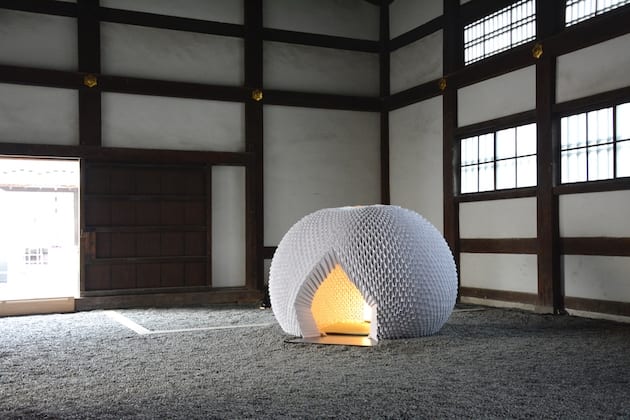 |||
|||
Katagiri Architecture + Design have collaborated with Akinori Inuzuka Design on Shi-An: a movable teahouse using a single material.
Inspired by Japanese ideas of the beauty of transient things, Shi-An hopes to embody the country’s values on space and environment. In being composed of small interlocking units, it references natural forms such as cells.
 Shi-An was first installed in the kitchens of a 17th century castle. Photo: Takuya Watanabe Photography
Shi-An was first installed in the kitchens of a 17th century castle. Photo: Takuya Watanabe Photography
It is constructed entirely from washi paper, a traditional Japanese material used for both origami sculptures and ukiyo-e prints. Washi is manufactured through an elaborate, lengthy handmade process.
 It is constructed entirely from identical units of folded washi paper. Photo: Takuya Watanabe Photography
It is constructed entirely from identical units of folded washi paper. Photo: Takuya Watanabe Photography
The architects were inspired by origami in creating a structural stability. They also used origami techniques in its modular assembly. 500 x 1000 mm sheets are each folded 8 times, creating a unit with two arms and two pockets. These units can be slotted together.
 The pavilion’s roof opens out to an oculus. Photo: Takuya Watanabe Photography
The pavilion’s roof opens out to an oculus. Photo: Takuya Watanabe Photography
This construction allows the pavilion to be easily deinstalled and reassembled, without any need for foundations. It also allows for customisation each time it is built, with different configurations of origami paper creating subtly different structures.
 The architects were influenced by organic forms and Japanese aesthetics. Photo: Takuya Watanabe Photography
The architects were influenced by organic forms and Japanese aesthetics. Photo: Takuya Watanabe Photography
Shi-An was first installed in the Daidokoro (‘kitchen’) of Nijo-Jo Castle, a UNESCO World Heritage Site in Kyoto. The castle was constructed in 1603 at the behest of Tokugawa Ieyasu, one of Japan’s unifying daimyos.
Set up by the Illinois Institute of Technology graduate Kazuya Katagiri in 2014, Katagiri Architecture + Design’s projects include interior and exhibition for Venture Labs in both Japan and the US, and the Hotel Oriental Express Tokyo Kamata. All three were completed in 2019. Many of Katagiri’s projects to date have been collaborative.
Katagiri Architecture + Design and Akinori Inuzuka Design have worked together on Shi-An, which is made entirely from washi paper
























